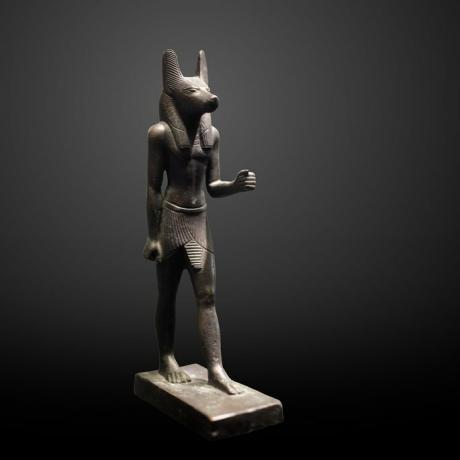Anubis is the egyptian god of the afterlife. As protector of helpless souls, he exercises the function of guiding the dead to the heavenly regions and assisting in their resurrection. As the first embalmer, according to the Osiris myth, Anubis is also known as the mummification god, that is, the one who, according to the ancient Egyptians, guarantees that people receive the treatment they deserve after death.

The cult of Anubis is very old, and there are images of the god Anubis in tombs of the First Dynasty (3200-2778 BC. Ç). There are also references to him in the Pyramid Texts, the oldest texts of the ancient Egyptian religion.
These texts are composed of funerary inscriptions recorded over 4,000 years ago inside the first pyramids of Ancient Egypt. Anubis and other gods are mentioned in these inscriptions for the purpose of protecting and assisting the dead (in this case, the pharaoh) in their transition towards eternal life in the aaru (Paradise).
Like many other Egyptian deities, Anubis is an anthropozoomorphic being - that is, half human, half animal. In some representations, it appears as a jackal-headed man. But there are pictures (see below) that show him simply as an animal, be it a jackal or a black dog.

The image of the jackal god or dog god is probably related to the behavior of the packs that lived in the deserts and went to cemeteries to “steal” the carrion from the shallowest graves. The canine god (dog or jackal) would be an answer to these tomb raiders, protecting the dead against all kinds of evil and guaranteeing them a dignified burial.
The name Anubis comes from anupu, which in turn derives from the Egyptian word inepe, which means "rot" or "putrify". The black color of the dog or jackal that represents Anubis has to do with the coloration that the body gains during mummification due to the use of some substances.
Story of Anubis: why he is the god of death

According to Egyptian mythology, Anubis was responsible for the funerary rituals of the god Osiris, the first pharaoh of the living world. Osiris was betrayed and killed by his brother Seth, who aimed to take the throne of Osiris. The body, placed inside a coffin, was thrown into the river. Queen Isis, wife of Osiris, found her husband's body and buried it to hide it from Seth.
But Seth found out what Isis had done. He found Osiris' body and cut it into many pieces, which were scattered all over the world. With this, he guaranteed that Osiris would never return to life.
But Isis didn't give up. With the help of the goddess Nephthys, she collected all the pieces of her husband and asked Anubis to take care of the rest. Anubis sewed up Osiris' body and embalmed it.
After that, Osiris was resurrected, but not to inhabit the world of the living again. He resurfaced in the underworld, becoming lord of the underworld. That's how Anubis became the first embalmer, being known in Ancient Egypt as a master of mummification.
See too:
- Definition of Mythology
- meaning of myth
- Ancient Egypt: summary of the history and characteristics of this civilization

